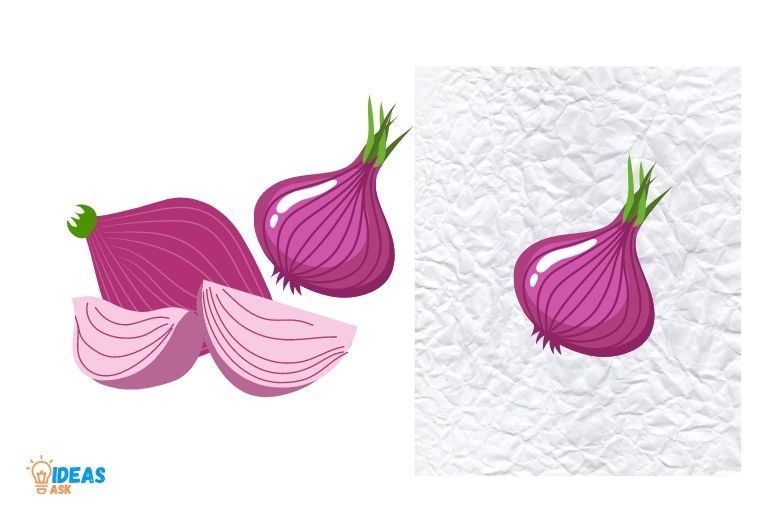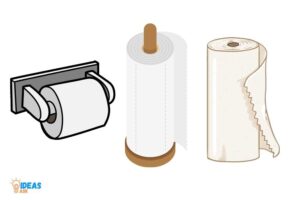Does a Wet Paper Towel Help With Onions? Yes!
Yes, a wet paper towel can help reduce the impact of onions on your eyes while cutting them.
When cutting onions, they release a gas called propanethial S-oxide. This gas reacts with the moisture in your eyes, producing a mild sulfuric acid, which leads to the stinging sensation and subsequent tears.
By using a wet paper towel, you can absorb some of the gas before it reaches your eyes, reducing the overall irritation.
To further minimize the impact of onions on your eyes, you can employ a few additional techniques alongside using a wet paper towel.
Using a sharp knife ensures cleaner cuts and less damage to the onion cells, which reduces the amount of gas released. Chilling the onion in the refrigerator for 15-30 minutes before cutting can also slow down the release of gas.
Lastly, cutting under a kitchen hood can help draw away the gas, minimizing its contact with your eyes.
Wet Paper Towel Help With Onions: Condition, Presence, Experience
| Condition | Wet Paper Towel Presence | Onion Cutting Experience | Notes |
|---|---|---|---|
| 1 | No | Unpleasant | Tears, irritation, and strong smell experienced while cutting onions. |
| 2 | Yes, placed under onion | Improved | Wet paper towel absorbs some onion vapors, reducing tears and irritation. |
| 3 | Yes, placed on cutting board | Slightly Improved | Wet paper towel helps to anchor onion, providing stability and reducing vapors. |
| 4 | Yes, used to wipe knife | Marginally Improved | Wiping knife with a wet paper towel may reduce some onion vapors while cutting. |
Key Takeaway

Five Facts About Wet Paper Towels on Onions
The Science Behind Onions
Onions are a staple in many kitchens, and while they add flavor to dishes, they can also bring tears to your eyes. But have you ever wondered why onions make us cry? We’ll delve into the science behind onions and the compounds that cause those pesky tears.
Overview Of The Chemical Compounds In Onions
Onions contain several chemical compounds that contribute to their pungent taste and aroma.
The two primary compounds are:
- Alliin: A sulfur-containing amino acid that has no flavor or odor
- Alliinase: An enzyme that turns alliin into a volatile compound called allicin
In addition to alliin and alliinase, onions also contain flavonoids, which are responsible for the onion’s color, and sulfur compounds, which give onions their distinctive smell.
Explanation Of How These Compounds Cause Tears
When onions are cut, their cells are damaged, and alliin and alliinase come into contact with each other. This reaction produces allicin, a volatile compound that readily evaporates into the air. Allicin is responsible for the distinctively pungent odor of onions.
It also reacts with the moisture in our eyes and respiratory system, forming sulfuric acid, which irritates our eyes and causes tears.
Detailed Explanation Of The Physical Properties Of Onions
Onions are made up of several layers of tightly packed cells that contain water, sugars, and various chemicals. They’re also rich in fiber, which makes them an excellent addition to a healthy diet.
Here are some interesting facts about onions:
- Onions come in different colors, including white, yellow, and red.
- The sharpness of an onion’s flavor and odor depends on its age, variety, and growing conditions.
- The more pungent the onion, the more sulfuric compounds it contains.
- Cooking onions can reduce their pungency by breaking down the sulfur compounds.
- Onions have a long history of medicinal use, and some studies suggest they may have anti-inflammatory and anti-cancer properties.
The science behind onions and their effect on our eyes is fascinating. The compounds responsible for the tears and pungent odor also provide many health benefits. From now on, when you’re cutting onions, remember that the tears are worth it!
The Role Of Moisture During Onion Cutting
Have you ever found yourself crying while chopping onions? Well, you’re not alone. Onions contain a gas called syn-propanethial-s-oxide, which produces the tears.
However, there is a common belief that a wet paper towel can help mitigate this issue. In this blog post, let’s investigate the validity of that belief.
How Moisture Affects Onions While Cutting
Onions contain water, which helps to preserve and provide structure to its cells. When an onion is cut, the cells are torn apart, releasing the syn-propanethial-s-oxide gas, which then evaporates in the air. The moisture from the onion cells can hasten the evaporation of this gas, leading to increased tearing.
Explanation Of The Effect Of Water On Onion Cells
When an onion is cut and exposed to the air, the gas responsible for tearing eyes is generated. However, if moisture is applied to the onion in advance, it assists in slowing down the production of the gas and decreases the amount of gas present in the air.
The moisture from the paper towel gets absorbed into the onion cells, which helps to keep them from releasing the tear-jerking gas.
Here are some bullet points that summarize how moisture affects the onion cells:
- Moisture assists in slowing down the production of the gas that makes you tear up when cutting onions
- The onion cells absorb the moisture from the paper towel and reduce their tendency to release the gases that evoke eye-tearing
- Due to this, a wet paper towel can assist in reducing the amount of gas present, lessening the tearing effect
How Moisture Can Reduce Tear-Inducing Gases
The use of a wet paper towel can help with the problem of onion-induced tears. The moisture in the paper towel can reduce the amount of syn-propanethial-s-oxide gas released from the onion, decreasing the amount of gas in the air.
It also helps to keep the onion cells moist, preventing them from releasing extra gas. Thus, moistening the onions with a wet paper towel before cutting can significantly decrease the number of tears shed.
Here are a few bullet points summarizing how moisture can reduce tear-inducing gases:
- Applying moisture early can slow the creation of tearing gases in onions
- The presence of moisture decreases the tear-jerking gas level in the air
- A wet paper towel can keep the onion cells moist and limit the release of syn-propanethial-s-oxide gas
- By limiting the amount of gas in the air, tears can be minimized or avoided altogether!
By using a wet paper towel when chopping onions, you can cut down on tears incredibly and diminish the inconvenience of tearing up.
Moisture is integral to reducing the creation of syn-propanethial-s-oxide gas and can reduce the amount of gas present in the air, which is the cause of tearing while cutting onions.
So, next time you’re in the kitchen, look towards the humble yet effective wet paper towel to help out with tearing eyes!
The Wet Paper Towel Method
Does A Wet Paper Towel Help With Onions?
Onions are one of the most commonly used ingredients in many dishes. While their flavor may be irresistible, their pungent scent can often be too much for some people to handle. The solution to this problem lies in the kitchen; using a wet paper towel!
How The Wet Paper Towel Method Works
The wet paper towel method works by capturing the sulfurous compounds released by the onion when you cut into it. These compounds are responsible for the onion’s strong, pungent odor.
When the wet paper towel absorbs these compounds, it helps to neutralize their scent, making it easier to work with onions without being overwhelmed by their smell.
Step-By-Step Instructions For Using The Wet Paper Towel Method
Here are the step-by-step instructions for using the wet paper towel method:
- Take a paper towel and wet it thoroughly.
- Wring out the excess water, so the paper towel is damp, but not dripping.
- Fold the paper towel in half.
- Place the onion on top of the folded paper towel.
- Wrap the damp paper towel around the onion.
- Proceed to cut the onion as desired.
Pros And Cons Of Using The Wet Paper Towel Method
Like every kitchen hack, the wet paper towel method has its share of pros and cons.
Here they are:
Pros:
- The wet paper towel method is simple and easy to use.
- It helps to neutralize the onion’s strong scent, making it easier to work with.
- The method is cheap, and the materials needed are readily available in most kitchens.
Cons:
- The wet paper towel method may not work as effectively for particularly pungent onions.
- The paper towel may not be able to capture all of the sulfurous compounds, leading to a lingering onion scent.
- If you’re working with a large number of onions, it may be challenging to use the method effectively for all of them.
The wet paper towel method is a simple yet effective way of dealing with the pungent scent of onions. While it may not work for all onions, it is still a useful technique to have in your cooking arsenal. Give it a try the next time you’re cutting onions, and see if it makes a difference!
Other Methods For Reducing Tears While Cutting Onions
When we cut onions, it can make our eyes water and sting. It is because they contain a gas that becomes an irritant to our eyes when it comes into contact with moisture. One common method to prevent this is using a wet paper towel.
But does that actually work? And are there any other methods that can be used to reduce tears while cutting onions? Let’s find out more.
Overview Of Alternative Methods
Apart from the wet paper towel trick, there are many other ways that can be used to prevent tears while cutting onions.
Here are some other alternative methods:
- Chill the onion: Place the onion in the refrigerator for 30 minutes before cutting it. The cold temperature will slow down the release of irritant gas, reducing the amount released into the air.
- Cutting the onion under running water: This method involves cutting the onion under a stream of water so that the gas is steam away before it can reach our eyes.
- Wearing goggles or glasses: This method involves wearing a pair of goggles to protect the eyes from the gas released when cutting onions. Swimming or skiing goggles which form a tighter seal are more effective.
Discussion Of The Effectiveness Of These Methods
All of these methods are effective in reducing tears while cutting onions. Each method works differently but effectively in its own way.
For example, the wet paper towel method may work by preventing the gas from reaching the eyes, whereas chilling the onion works by slowing down the gas release.
Pros And Cons Of Each Method
- Wet paper towel:
- Pro: Simple to do, and does not require any special equipment.
- Con: It may not fully prevent the release of gas, and the towel may need to be constantly wetted.
- Chill the onion:
- Pro: Simple to do and does not require any special equipment.
- Con: It takes more time than other methods. The onion must be placed in the fridge for at least 30 minutes before use.
- Cutting the onion under running water:
- Pro: It’s effective in reducing onion tears while cutting, and no special equipment is necessary.
- Con: Water droplets can interfere with the cutting when using this method.
- Wearing goggles or glasses:
- Pro: It’s very effective in preventing tears, and the vision is not compromised while cutting onions.
- Con: It requires wearing additional equipment while cooking. The goggles may become foggy when used for several minutes.
While the wet paper towel method is still practical, it’s worth trying different methods, especially if the gas irritates you a lot.
Different methods may work differently with different people. So, you have to decide which method works best for you and enjoy your onions without tears!
FAQ About Wet Paper Towels on Onions
Why Do Onions Make You Cry?
Onions contain sulfur compounds which irritate the eyes, causing us to tear up.
How Does A Wet Paper Towel Help With Onions?
Placing a wet paper towel on your cutting board can help reduce the amount of irritants released from the onion.
Can You Use Other Methods To Reduce Onion Tears?
Yes, you can try using a sharp knife, chilling the onion, or cutting it under running water to reduce onion tears.
Does The Wet Paper Towel Method Work For All Types Of Onions?
Yes, the wet paper towel method can work for all types of onions and is a simple and effective way to reduce onion tears.
Conclusion
As we wrap up our investigation into whether or not a wet paper towel helps with onions, it’s important to recognize that personal preferences can greatly affect the results. Some individuals may find that a damp paper towel eases their discomfort while cutting onions, while others may find it does not make a difference.
Nonetheless, it’s exciting to see that many people have found success in using this simple kitchen hack to reduce the tears while prepping onions for their favorite dishes. It’s also worth noting that a damp paper towel can potentially reduce the amount of quercetin released from onions during cutting, making it a healthier option for those with allergies or intolerances.
Above all, experimenting with different methods and techniques is the key to discovering what works best for you and your cooking style. So go ahead, give a wet paper towel a try next time you’re cutting onions and see if it makes a difference!





